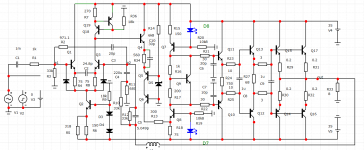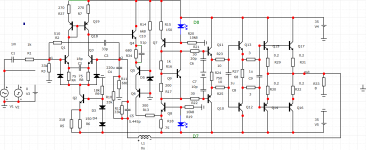How about adding current mirror?
LTP runs now at lower 1.2 mA, and it's symmetrical.
Q5 can be a small transistor (46mW now, it was over 100mW before).
LTP runs now at lower 1.2 mA, and it's symmetrical.
Q5 can be a small transistor (46mW now, it was over 100mW before).
Attachments
Last edited:
One thing I don't understand:
It seems like the input stage is responsible for slew-rate.
It's not the output, it's not the VAS.
As we see here (Kletzov amp) - same VAS, same output, but slew rate is higher.
Why then - when I replace an op-amp with faster one - the overall slew rate stays the same (15V/us) ?
I'm talking about LMK/Wiederhold amps.
For example: I tried TLE2071, which is a drop-in replacement for TL071, but it has SR 45V/us.
It didn't make any difference for the overall (measured) slew rate
It seems like the input stage is responsible for slew-rate.
It's not the output, it's not the VAS.
As we see here (Kletzov amp) - same VAS, same output, but slew rate is higher.
Why then - when I replace an op-amp with faster one - the overall slew rate stays the same (15V/us) ?
I'm talking about LMK/Wiederhold amps.
For example: I tried TLE2071, which is a drop-in replacement for TL071, but it has SR 45V/us.
It didn't make any difference for the overall (measured) slew rate
Last edited:
So it means that we need op-amp to swing in higher voltage range (not just ~600mV) to get higher SR?
What is your opinion - is it worth to pursue higher slew rate (and making some other compromises) ?
Or just settle down on 15V/us ?
What is your opinion - is it worth to pursue higher slew rate (and making some other compromises) ?
Or just settle down on 15V/us ?
Last edited:
No.We need a quiet, fairly fast opamp and no more. We need to increase the speed of the discrete part.So it means that we need op-amp to swing in higher voltage range (not just ~600mV) to get higher SR?
>We need to increase the speed of the discrete part.
Which part exactly?
Voltage shifter/buffer?
Your latest design already has 1 op-amp + 4 transistors + VAS + output, and SR is still 15V/us...
Not sure if/how this can be improved further...
Which part exactly?
Voltage shifter/buffer?
Your latest design already has 1 op-amp + 4 transistors + VAS + output, and SR is still 15V/us...
Not sure if/how this can be improved further...
Last edited:
In the model or in the hardware? In the MS model, the speed is higher>We need to increase the speed of the discrete part.
Which part exactly?
Voltage shifter/buffer?
Your latest design already has 1 op-amp + 4 transistors + VAS + output, and SR is still 15V/us...
Not sure if/how this can be improved further...
>In the model or in the hardware? In the MS model, the speed is higher
In the spice model of your latest design, AFTER adjustments were made to handle square waves correctly, SR still is around 15V/us.
It was somewhat higher BEFORE square waves adjustments... but not anymore.
This discrete amp seems to be handling square waves much easier.
In the spice model of your latest design, AFTER adjustments were made to handle square waves correctly, SR still is around 15V/us.
It was somewhat higher BEFORE square waves adjustments... but not anymore.
This discrete amp seems to be handling square waves much easier.
Well it seems to have corrected the amplifier with a gain of 180 degrees while maintaining the gain. Not much,but we'll fix it later
Shouldn't R3 (input R) be half lower?
That's not current mirror.... That's current source..
Last edited:
Shouldn't R3 (input R) be half lower?
That's not current mirror.... That's current source..
R3 is equal to R12/ private OOS with AC and DC
yesThat's not current mirror.... That's current source..
R10 doesn't affect this formula?
I thought R10/R12 should be treated as being parallel.
If R3=17k, Thd is lower.
I thought R10/R12 should be treated as being parallel.
If R3=17k, Thd is lower.
R10 doesn't affect this formula?
I thought R10/R12 should be treated as being parallel.
If R3=17k,is lower.
Classic. 2-component feedback.
R3/R12/R10 can be changed.
With a current mirror, there is less distortion.
Last edited:
Beautiful amplifier turns out. With mirrorI rechecked - no difference. I was mistaken.
Attachments
Last edited:
- Home
- Amplifiers
- Solid State
- Unusual amp from 1987



